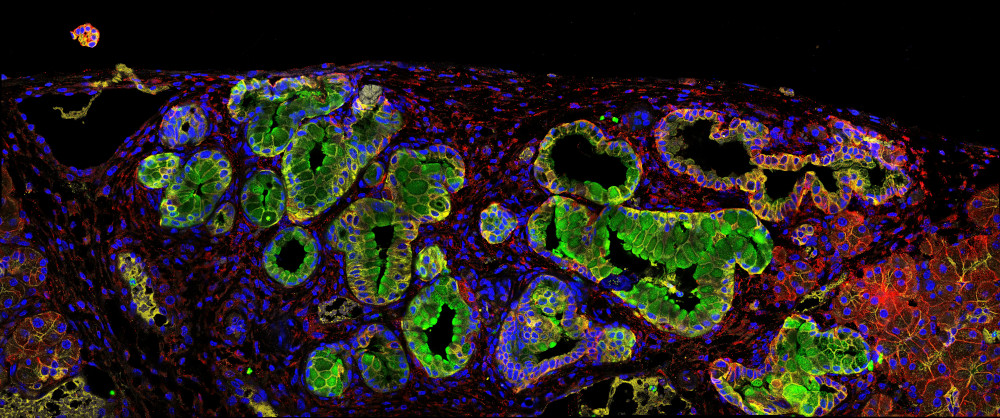The team led by Dr. Bruno Sainz, principal investigator of the study published in the prestigious journal GUT, describes how pancreatic cancer stem cells exploit an antibacterial protein to evade the immune system and protect themselves from early elimination
This work published in GUT, a leading journal in the field of gastroenterology, is title “The Peptidoglycan Recognition Protein 1 confers immune evasive properties on pancreatic cancer stem cells”. It has been co-led by Dr. Bruno Sainz, head of the Cancer Stem Cells and Fibroinflammatory Microenvironment Group at the Instituto de Investigaciones Biomédicas Sols-Morreale (IIBM), CSIC-UAM and the Biomarkers and Personalized Approach to Cancer Group (BIOPAC) at the Ramón y Cajal Institute for Health Research (IRYCIS); Dr. Christopher Heeschen from the Candiolo Cancer Institute (IRCCS) in Italy and Dr. Susana García-Silva, Staff Scientist at the Spanish National Cancer Research Centre (CNIO).
Over the past ten years, Drs. Sainz, Heeschen, and García-Silva have led a collaborative project in which they identified a population of pancreatic cancer stem cells (CSCs) present in mouse models of this disease. These cells, known as the root of the tumor, are responsible for disease recurrences after chemotherapy or radiotherapy. Interestingly, pancreatic cancer is also one of the most resistant tumors to immunotherapy. However, to date, the mechanisms by which CSCs manage to evade elimination by the immune system are not clear. In an immunologically cold tumor, such as pancreatic cancer, finding new therapeutic targets that can facilitate the recognition and elimination of tumor cells is vital to improve the effects of immunotherapy, considered the new hope for cancer treatment. The study, initiated by Dr. García-Silva at the CNIO, and continued by Juan Carlos López-Gil, a predoctoral researcher in Dr. Sainz's laboratory and supported by the La Caixa Foundation for the development of this project at the IIBM, has identified the protein Peptidoglycan Recognition Protein 1, PGLYRP1, as one of the mediators of CSC immune evasion. The work, which made use of sophisticated mouse models and patient samples, has explained for the first time the role of PGLYRP1 in pancreatic cancer and has laid the groundwork for developing treatments against this protein.

Immunofluorescence of a pancreatic tumor; PGLYRP1 protein is stained green
"When we eliminate PGLYRP1 from tumor cells, we see that the immune system responds by attacking them, preventing the formation of the primary tumor and metastatic spread," highlights Dr. Sainz. "We are now developing therapies to block or eliminate this protein with the hope of being able to combine them with current treatments to more efficiently attack and eliminate cancer stem cells, the root of the tumor." Over the past four years, Juan Carlos López-Gil has been able to decipher why CSCs produce this protein in pancreatic cancer. "We have seen that immune cells try to eliminate tumor cells by producing tumor necrosis factor. PGLYRP1 is very similar to this factor and interacts with the same receptor, blocking it. In the end, CSCs protect themselves by using an incomplete key (PGLYRP1) to block the lock (the receptor) and thus avoid death caused by tumor necrosis factor (the complete key)," explains Juan Carlos. "It is curious how a protein used by our immune defense system to combat bacteria is used by pancreatic cancer to protect itself from those same defenses," says Dr. García-Silva, who ensures that "understanding the mechanisms by which tumor cells hijack physiological processes is key to being able to 're-educate' the environment surrounding the tumor to react against it."
The results of this outstanding research have been published in collaboration with other IIBM researchers, including Drs. Ana Monfort-Vengut and Guillermo de Cárcer, and with the support of the La Caixa Foundation, the Fero Foundation, the Pancreatic Cancer Association (ACANPAN), the Spanish Association of Pancreatology (AESPANC), the Spanish Association Against Cancer, the Carlos III Institute (ISCIII), and the Ministry of Science, Innovation and Universities (MICIU), as well as the CIBERONC gastrointestinal tumors program.
The paper: “The Peptidoglycan Recognition Protein 1 confers immune evasive properties on pancreatic cancer stem cells” can be read AQUÍ
On the cover photo is the Cancer Stem Cells and Fibroinflammatory Microenvironment Group. Left to right: Juan Carlos López-Gil, Laura Ruiz-Cañas, Bruno Sainz Anding, Sandra Batres Ramos, Sonia Alcalá Sánchez, Adrián Palencia Campos, Diego Navarro Vera